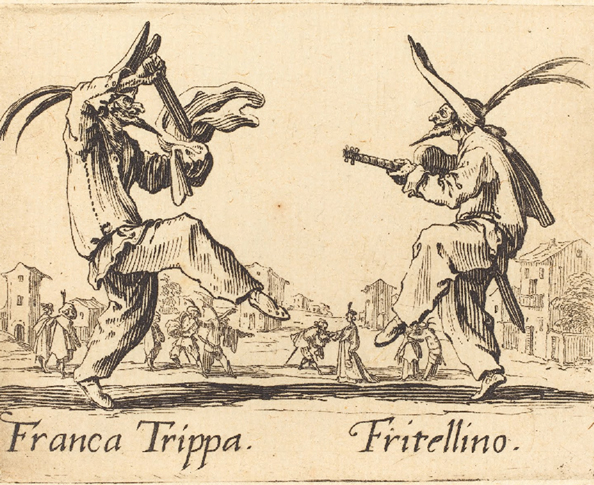-Lucie-Jansch-2011---HiRes.jpg)
Puccini’s
Turandot was inspired by Schiller’s early-19th-century German adaptation of an 18th-century Italian comedy by Carlo Gozzi, who drew on a French retelling of a supposedly traditional Persian fairytale set in ancient China. Gozzi created a piece in the style of
commedia dell’arte, a codified theatre form with set characters, story lines, and gestures. But it was a structure within which the performers were allowed to improvise. My own work starts out being free and improvised, and ends up being highly formal and mechanical. My work and
commedia are both close to Vaudeville, where performers repeated acts over and over, and broke them down technically so they became free to concentrate on timing. Comedy is all about timing.
 Commedia dell’arte characters of Franca Trippa and Fritellino, etchings by Jacques Callot (c. 1622)
Commedia dell’arte characters of Franca Trippa and Fritellino, etchings by Jacques Callot (c. 1622)
Puccini invented the names Ping, Pang, and Pong for his three comic characters, but they are straight out of the baroque theatre of Italy. They are Pantalone, Tartaglia, Brighella, and Truffaldino, the Venetian figures of street and puppet theatre, of carnival and clowning who Gozzi always incorporated into his comedies of errors whether in metropolitan Rome, ancient Ceylon, Tbilisi, or Turandot’s fantastical China. They are the masked stock characters of
commedia dell’arte, physical comedians in league with the audience who could step out of the action, comment, and laugh about it. Puccini gave Gozzi’s Venetian clowns-asimperial- ministers the woes of contemporary bureaucrats and paper pushers, pining for a simpler life away from the capital and Turandot. However, he also gave the figures naively pseudo-Asian names to place them in the exotically orientalist world he had created for his early-20th-century audiences. To our ears, these names are dated and offensive, and they now detract from the figures’ place in the work as sarcastic, slapstick commentators of the goings-on at court. That is why, in this production, we are calling the three ministers Jim, Bob, and Bill.
In this tradition of masks, as I do in each of my productions, whether I am directing Shakespeare, Sophocles, Beckett, or Wagner, the actors’ faces have been whitened and painted over with expressionist features. Because of the contrast between light and dark this creates, our eyes go first to the actors’ faces. And with a smile, a grimace, a glance, the audience can grasp something about the characters and their situation. They are like the stars of silent films, Vaudeville, or the masks of
commedia dell’arte with their exaggerated appearance. Buster Keaton’s face was heavily made-up. His face was like a mask. He created a language with his face. It is very different from modern ideas of psychology.

(l-r) Buster Keaton in Go West! (1925); Miren Urbieta Vega as Liù in the Robert Wilson’s production of Turandot in Madrid (2018)
Often when people stage
Turandot it is extravagant fake chinoiserie, using all the clichés of Chinese culture. With Puccini’s music, one has to be careful not to do too much. There is an interior beauty to the stories and characters that is often overlooked or lost. With the opera’s overwrought emotions, in the music and the libretto, sometimes you have to interrupt it and change the rhythm. Otherwise it becomes monotonous. You are hitting the audience on one level only, continuously, and they stop listening, they stop seeing, they can no longer hear. Humour is essential for anything you do. My work is simultaneously full of multiple, different and changing speeds of energy, different registers. When Liù dies, you have to have laughed a little bit beforehand, otherwise it will not truly be tragic. Puccini understood that need for humour.
Robert Wilson
Director,
Turandot
Join us for
Puccini's Turandot, on stage from September 28 to October 27, 2019 at the Four Seasons Centre for the Performing Arts.
 YOU MIGHT ALSO LIKE...Your Guide to Puccini's TurandotThe Turandot Problem by Richard Lee
YOU MIGHT ALSO LIKE...Your Guide to Puccini's TurandotThe Turandot Problem by Richard Lee
Photo credit: Robert Wilson by Lucie Jansch, 2011; R.L. Baumfeld Collection, National Gallery of Art (Washington, DC, USA); Everett Collection Inc / Alamy Stock Photo; Turandot
production photo by Javier del Real.-Lucie-Jansch-2011---HiRes.jpg)
 Commedia dell’arte characters of Franca Trippa and Fritellino, etchings by Jacques Callot (c. 1622)
Commedia dell’arte characters of Franca Trippa and Fritellino, etchings by Jacques Callot (c. 1622)
 YOU MIGHT ALSO LIKE...
YOU MIGHT ALSO LIKE...